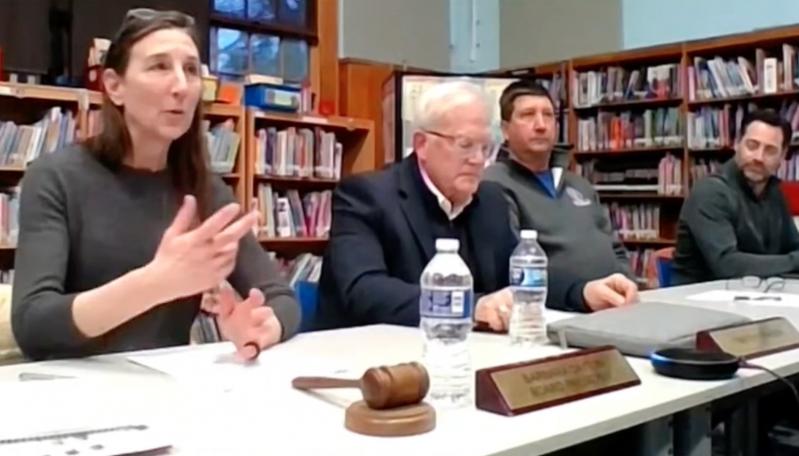Since New York State’s cap on tax-levy increases was enacted in 2012, the Springs School District has never attempted to pass an over-the-cap budget. That’s about to change.
School officials on Tuesday unveiled a budget proposal of $35.45 million for the 2023-24 school year that reflects the rising costs of high school tuition, fuel, employee benefits, cybersecurity measures, and debt payments. The budget also adds teachers and support staff in key areas and supports an overhaul of the math curriculum.
At least 60 percent of Springs voters must say “yes” to the plan for it to pass, presenting a big challenge for a school district that already asks its residents to pay the highest school-tax rate in East Hampton Town.
It’s a dilemma years in the making. Over the last several years, Michael Henery, the business administrator, has been predicting that the 2023-24 fiscal year would be the critical year in which an over-the-cap budget would be necessary. And Barbara Dayton, the school board president, pointed out that Springs has been scaling back year after year in an effort to be mindful of the school-tax burden on district taxpayers.
“We were really cutting budgets down lower than honestly you advised us to,” Ms. Dayton said to administrators on Tuesday, “and that was a board decision. . . . You pay now or you pay later, and now we’re having to ‘pay later’ for the stuff that we tried to help out with before.”
The $35.45 million proposal carries a tax-levy increase of 5.31 percent, which is higher than the 2.14-percent cap to which Springs would otherwise have to adhere. Here’s the kicker: That 5.31-percent increase is actually slightly lower than last year’s tax-levy increase of 5.46 percent, which only needed a simple majority of voter approval to pass. The difference is primarily tied to debt payments — known in school-finance speak as “exclusions” — that are now kicking in on the $23 million Springs borrowed to pay for the major building expansion and renovation plan that it recently completed.
Mr. Henery said Springs would need to cut about $1.9 million in order to comply with the tax-cap rules. At another budget workshop on Tuesday, he will present to the school board potential areas where cuts can be made. “It’s going to be very difficult to get down to that number,” he said.
A key factor in the budget is tuition to East Hampton High School for children who graduate from Springs. East Hampton charges $24,595 per general-education student; for special education, self-contained classroom tuition is $68,269 and hybrid-classroom tuition is $44,210 per student.
Springs anticipates spending about $688,673 more in tuition expense next year because its enrollment at the high school is growing and because the tuition rates themselves are going up. Mr. Henery explained that for the general-education students, $151,432 of the increase is due to the tuition rate increasing and $491,912 is due to the rising enrollment.
“We’re piercing the cap just on high school tuition alone,” said Debra Winter, the district superintendent.
Ms. Dayton asked Mr. Henery to budget for a contingency of 10 high school students in case Springs sees a midyear enrollment influx — which, based on yearly enrollment trends, is nearly a certainty. With those additional students added in, the budget proposal would rise to $35.7 million and the tax-levy increase to 6.15 percent.
“To not plan for that would not be good for the students here” at the Springs School, Ms. Dayton said. “I don’t want to be cutting any programs or fun stuff for our kids. We’re trying to build up some of our programs. If they don’t come, [the money] comes back into the fund balance. If they do come, at least we have a safety net.”
For students in the Springs School, the budget proposal would promote a part-time Spanish teacher to full-time so that more elementary kids can learn Spanish — which was a direct request from parents who fear their children are going to lag behind East Hampton kids who get Spanish lessons much more frequently. Two more special-education teaching positions are in the mix so that each grade can have at least one dedicated special education teacher — which reflects a desire among the teachers themselves to better serve their kids by not straddling classroom assignments.
The budget plan also converts a part-time guidance counselor position to full-time so that more mental health support can be offered. Another proposed addition is a custodian job to help keep that new-and-improved building in great shape.
Salary increases for employees, based on bargaining agreements with the Springs Teachers Association and other employee units, will cost the district $476,722, up to $12.56 million. Benefits for full-time employees will rise by $630,599, up to $6.38 million.
At the budget workshop planned for Tuesday at 7 p.m. in the school library, Mr. Henery said he plans to detail how the proposed tax-levy increase will impact the taxes that homeowners pay. The budget vote is on May 16.
In other Springs School news, the district on Tuesday hired a new business official, Steven Guarini, at a salary of $150,000. He starts May 1. Because he lives in Nassau County, Ms. Winter said, Mr. Guarini will work a hybrid in-person/remote schedule. He previously was district treasurer in Hempstead. “He is hard-working and diligent,” Ms. Winter said.
The school board also added another proposition to the May 16 budget ballot, asking taxpayers to approve the purchase of a new school bus at $90,000.
This story has been updated to correct Ms. Dayton's statement about prior years' budget cuts.

